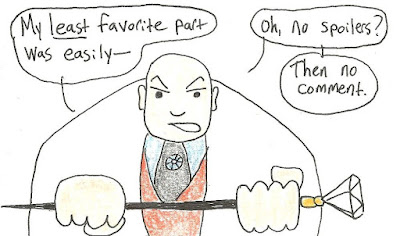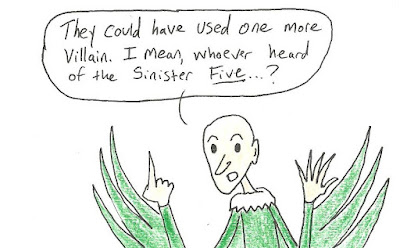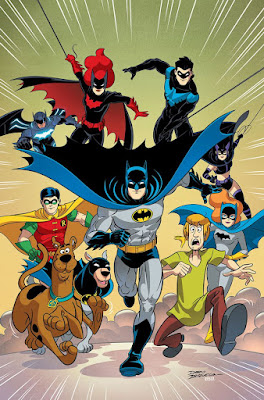Sunday, December 26, 2021
Thursday, December 23, 2021
Marvel's March previews reviewed
The thing is, in Immortal Hulk it was a fairly literal title, as Al Ewing's then new take on the Banner/Hulk relationship was that if Banner was killed, he would come back to life as the Hulk the next night. Here I am assuming that "Immortal" is meant to be more figurative, but I don't know, I haven't been reading X-Men in a while...I guess there's some new weird technology on Krakoa that allows them to resurrect dead X-Men easily, right? (Well, more easily, I guess I should stay, as X-Men don't exactly have a tendency to stay dead for very long at all.)
Anyway, I won't be too terribly surprised if we see an Immortal Spider-Man, Immortal Guardians of the Galaxy or Immortal Ghost Rider in the near-ish future...
Word on the street is that The Punisher is getting a new logo/sigil in his new book, Punisher by Jason Aaron, Jesus Saiz and Paul Azaceta, but it wasn't on any of the three covers released with this solicitation, so I guess I'll hold off on making fun of it and/or pointing out better, more obvious alternatives...including, of course, no logo at all.
Saturday, December 18, 2021
DC's March previews reviewed
...
Although if DC is publishing 1,000+-page complete collections of various event series, where's my Eclipso: The Darkness Unleashed Omnibus or Bloodlines Omnibus, huh...?
In fact, I'd buy an omnibus of just about any of the annual events, even the ones that were more "thematic" crossovers, like the Year One, Legends of The Dead Earth, Elseworlds, or those great pulp-influenced annuals...
The solicitation copy for Justice League #74 says this is the end of the Brian Michael Bendis-written Justice League, which seems...abrupt. I'm not sure exactly how many issues he wrote, but the first arc isn't even available in trade yet and his run is already ending...? Seems like more of a fill-in arc than a run, then; I mean, I think there were at least as many issues between the end of Scott Snyder's run and the beginning of Bendis' as there were of Bendi's run proper, but I'd have to count and do math to be sure.
Saturday, December 11, 2021
A little bit more on Guillem March's Joker Vol. 1...
Naturally, Alan Moore and Brian Bolland's 1988 Batman: The Killing Joke is therefore repeatedly referenced, being not only one of the most widely-read and influential Joker stories, but also because it was specifically about The Joker's attempt to drive Gordon "mad", in part by attacking and torturing his daughter, Barbara Gordon.
The Joker Vol. 1 is very much a comic book in conversation with other comic books, particularly The Killing Joke, but there are other conversations happening as well (like, for example, Tynion seemingly criticizing the climax of Tom King's run on Batman by having The Joker offer his professional criticism on how best to hurt Batman to Bane, as previously mentioned in my review of the book).
Because the events of The Killing Joke are so often referenced, we get the opportunity to see March draw scenes from that storyline in his own style, and, from a certain perspective, it is certainly interesting to see how March does so, having to be clear in what he's referencing while also making the imagery his own.
Above is a scene from the first issue of The Joker, offering a pretty direct "cover" version of a Bolland image of the Joker, right down to mimicking the pose.
 |
| Bolland |
 |
Batman doesn't appear as often as one might expect in The Joker, his appearances in the first collected volume mostly clustered around the beginning as the premise of the series is set up, but here's his first appearance in the book, crouching like a gargoyle on a bit of Gotham architecture, as is his wont.
Wednesday, December 01, 2021
A Month of Wednesdays: November 2021
BOUGHT:
Batman: The Long Halloween Special (DC Comics) It's been 21 years since the conclusion of Dark Victory, Jeph Loeb and Tim Sale's year-long sequel to The Long Halloween, itself a year-long series set in the same milieu as a trio of Legends of The Dark Knight Halloween specials the creative team produced between 1993 and 1995.
As for this 48-page special, it is set after the events of The Long Halloween and Dark Victory, mentioning plot-points and continuing themes from both, but despite that, it more precisely echoes those three LDK specials, with a relatively minor villain making a big attack on Halloween night.
Here that villain is the Calendar Man, free of Arkham, where he spent the two Loeb/Sale series as a sort of Hannibal Lecter figure, and on a spectacular crime spree with two objectives, one as a sort of typical calendar theme, the other to get revenge against Two-Face for stealing his thunder with the Holiday murders (It's been a long time since I've revisited Long Halloween, but Dent was one of, what, three Holiday killers? Was that right?)
Unfortunately, Sale doesn't outfit Calendar Man in his costume, which he actually draws the hell out of (as seen in 1993 Shadow of The Bat arc, "The Misfits"), but in a simple robe, the months of the year tattooed around the crown of his head counting as his "costume," I guess; it's a little too bad, as the full red costume would have set this more squarely in the Silver Age than the "Year One" era with, like, eight Halloweens in it, but given that Calendar Man has inspired a sort of cult with acolytes and is based in a church here, I suppose this look is more fitting.
As for the plot, beyond the Calendar Man business, Gilda Dent goes looking for Harvey and finds him, something that will apparently be explored more in some future Loeb/Sale collaboration (the last panel includes a box reading "The End" and a scroll just below it reading "For Now..."), and Batman and Gordon continue to ruminate on their alliance with Harvey Dent and how it was broken. Meanwhile, Robin is just starting to get involved in Batman's crime-fighting.
It was obviously a blast to see the Loeb/Sale team again. Loeb takes a lot of heat for a lot his writing, much of which can, admittedly, be quite bad. He's always done his best work with Sale on Batman, though, something I thought might have had to do with his editor, the late Archie Goodwin, but this is still quite good, and Goodwin obviously isn't around (Ben Abernathy is the editor, and there's a nice "special thanks" given to Goodwin).
Overall though, this was a lot of fun, and I sure wouldn't mind if Loeb/Sale Halloween one-shots became an annual traditions again, or if we get a follow-up to Dark Victory involving the Dents, as this issue seems to suggest, if not promise*.
Deadpool: Black, White and Blood #4 (Marvel Entertainment) I'm not exactly sure how this random issue of the limited palette Deadpool anthology series ended up in my pull-file at my local comic shop. The random issue of the limited palette Deadpool anthology series that I wanted was #3, the issue with the Stan Sakai contribution in it. So either I mistakenly told my local comic shop to order the wrong one, or they proceeded to order the wrong one. Buying comics is incredibly hard! That's why I do less and less of it.
While I'm bummed I'll have to wait on the Sakai Deadpool story, I wasn't too upset to receive this one, as it does contain a Mike Allred story (and cover!), and I've never regretted reading a Mike Allred-drawn comic.
The Allred story opens with Deadpool asleep in an empty theater playing an X-Statix movie, in full-color, when Doop slips a special pair of high-tech looking glasses over his eyes; from there he "wakes up" in what appears to be a different dimension, where everything is black and white and red. Lighter on jokes than the preceding two stories, it nevertheless has a solid premise and it's always great to see Allred drawing Marvel characters.
It's been something like 20 years since Doop first appeared, and I still haven't been able to decipher Doop speak... (Oh hey! I just checked and it's actually been 20 years exactly! Why was there no big Doop anniversary special, Marvel? Maybe start planning down for 2026's 25th anniversary of Doop now!).
The Allred story is preceded by two others; Chistopher Yost and Martin Coccolo's "Cherry" and Sanshiro Kasama and Hikaru Uesugi's "Samurai Version."
The first is probably the most typical Deadpool comic, with the character talking a mile a minute, narrating his adventure in fourth-wall-breaking dialogue (and commenting on the color choices throughout) and then ultimately facing an utterly ridiculous threat that I won't spoil here. Pretty great use of the limited palette, though.
The second is, according to a one-page introduction, is " a special story from the Deadpool Samurai team," published in Japan. It was apparently free online and was, according to Deadpool, "the most-read comic all over the world in 2020," but, um, I obviously didn't read it. It doesn't seem necessary to follow the story, such as it is; a goofy-looking fighter challenges Deadpool to a fight and loses. The manga style is a fun departure from what we normally see in a Marvel comic, but there isn't otherwise much to it.
Anyway, I got it.



















































